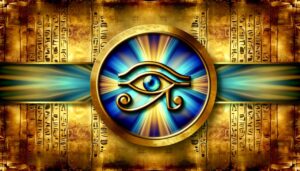What Is the Spiritual Meaning of Bow and Arrow Symbols?
The bow and arrow symbol encompasses a rich tapestry of meanings across various cultures and historical contexts. Historically, it signifies military prowess and technological advancement.
Mythologically, it is linked to divine figures like Artemis and Cupid, symbolizing hunting prowess and the complexities of love. Culturally, it embodies spiritual focus, ancestral connection, and cosmic order in societies from Native American to Hindu traditions.
Artistically, it represents heroism and social commentary. As a metaphor, it highlights precision, clear objectives, and methodological focus.
These diverse interpretations offer profound insights into how societies perceive power, intent, and spiritual journeys across time. Continue to unravel its multi-dimensional significance.
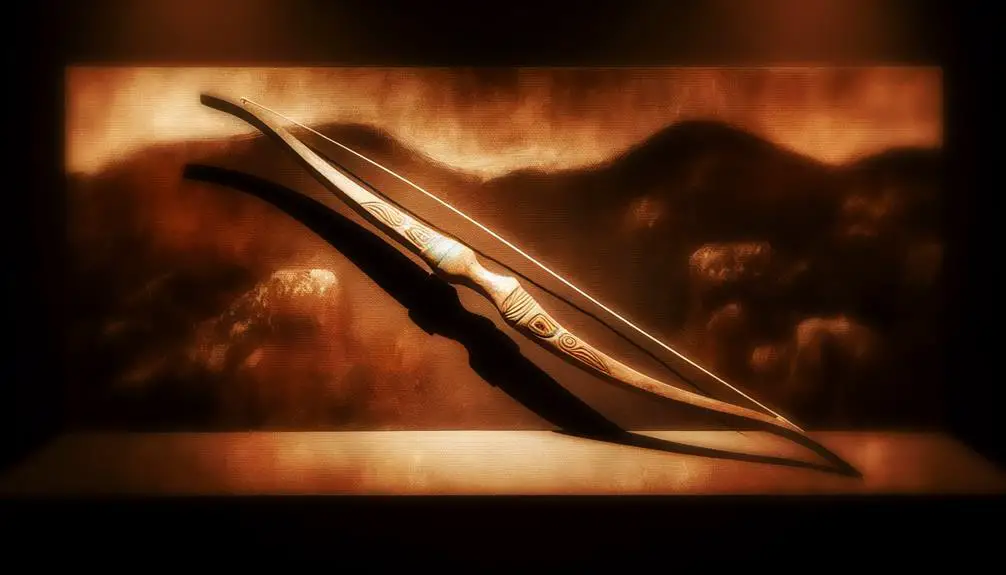
Key Takeaways
- Represents focus, precision, and the pursuit of goals through deliberate action.
- Symbolizes personal empowerment, resilience, and self-reliance.
- Embodies spiritual connection, mindfulness, and inner journey towards enlightenment.
- Historically signifies power, protection, and divine favor in various cultures.
- Reflects harmony between skill and knowledge, highlighting accuracy and meticulous technique.
Historical Significance
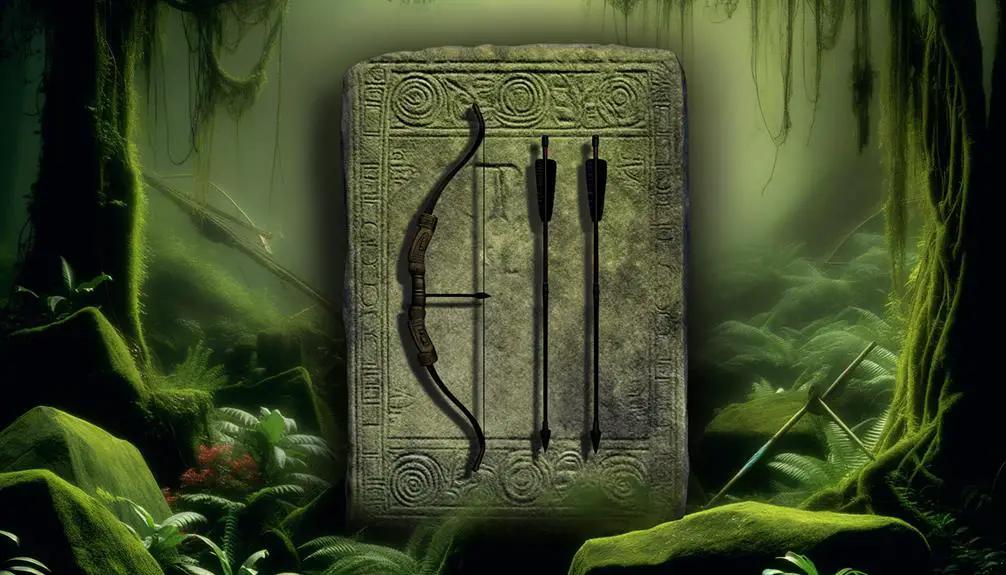
Throughout history, the bow and arrow have served as pivotal tools in hunting, warfare, and cultural rituals, reflecting their profound significance across various civilizations.
Archaeological evidence indicates their use dating back to the Paleolithic era, underscoring their role in early human survival.
In ancient societies such as Egypt, Mesopotamia, and China, these implements were integral to military strategies, enabling ranged combat and influencing the outcomes of numerous battles.
Moreover, the bow and arrow held ceremonial importance, symbolizing power, precision, and divine favor. Their representation in art, literature, and iconography highlights their multifaceted roles and enduring legacy.
The technological advancements and strategic applications of the bow and arrow have left an indelible mark on human history, shaping societal structures and cultural identities.
Mythological References
Mythological references to the bow and arrow abound, with notable examples found in Greek mythology. The Greek goddess Artemis, known for her hunting prowess, wielded a bow and arrow as symbols of her dominion over nature and wildlife.
Similarly, Cupid's arrows represent the potent and often unpredictable nature of love, illustrating the weapon's dual role in both combat and romance across mythological narratives.
Greek God Artemis
As the revered goddess of the hunt, wilderness, and chastity in Greek mythology, Artemis is frequently depicted wielding a bow and arrow, symbolizing her prowess and autonomy. This armament not only represents her martial skill but also underscores her role as a protector of nature and a symbol of independence.
The bow and arrow serve as metaphors for her precision and unwavering focus. Artemis's association with these weapons also highlights her role in rites of passage and the progression to adulthood, as she was venerated by young women seeking guidance.
Moreover, her mythological narratives often emphasize themes of vengeance and justice, wherein the bow and arrow become instruments of divine retribution, reinforcing her image as an unyielding deity.
Cupid's Love Arrows
Cupid's arrows, central to numerous mythological tales, symbolize the unpredictable and often uncontrollable nature of love, affecting both gods and mortals alike. These arrows, imbued with divine power, serve as metaphors for the sudden and transformative impact of affection and desire.
Cupid, or Eros in Greek mythology, wields two distinct types of arrows: those that inspire love and those that incite aversion.
- Golden Arrows: Cause an intense, immediate attraction.
- Lead Arrows: Induce repulsion and aversion.
- Symbolism: Represent the duality of love's joy and pain.
This dichotomy underscores the nuanced and capricious essence of love, illustrating how it can elevate and devastate with equal potency. The mythology of Cupid consequently provides a rich, allegorical framework for understanding the complexities of human emotion.
Cultural Symbolism
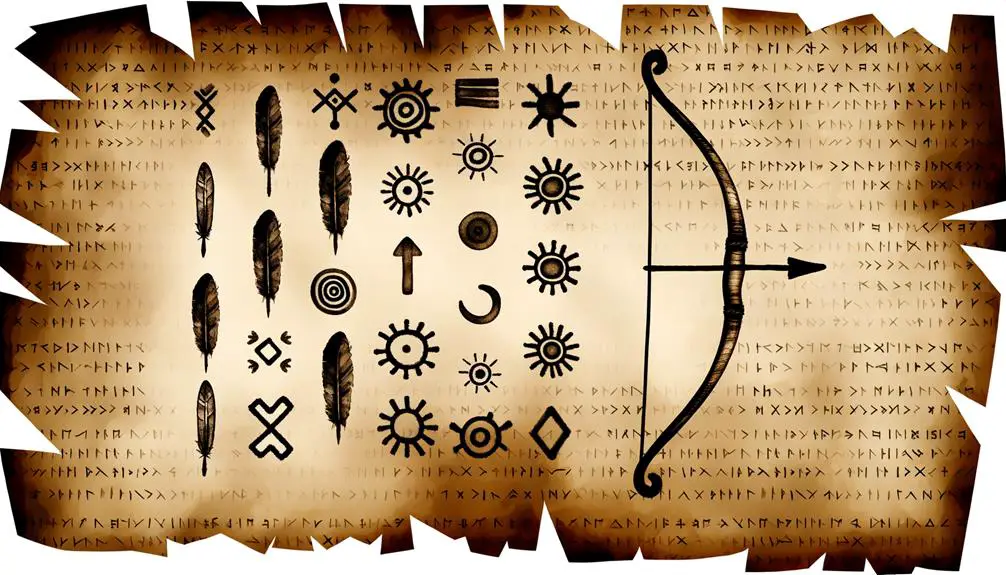
Examining the cultural symbolism of the bow and arrow reveals its multifaceted significance across various societies and historical periods. From ancient mythologies to modern interpretations, this weapon has represented more than just a tool of warfare or hunting. In various cultures, it embodies concepts such as protection, power, and focus.
| Culture | Symbolism |
|---|---|
| Greek | Divine intervention |
| Native American | Spiritual connection |
| Japanese | Zen and mindfulness |
| Hindu | Cosmic order and justice |
In Greek mythology, the bow and arrow are often associated with gods like Apollo, symbolizing divine intervention. Native American traditions view it as a spiritual link to ancestors. In Japanese culture, it represents the principles of Zen and mindfulness, while in Hinduism, it signifies cosmic order and justice.
Artistic Depictions
Artistic depictions of the bow and arrow throughout history reveal a rich tapestry of symbolic meanings, reflecting the cultural and philosophical contexts in which they were created. The imagery of these weapons has been employed in various mediums, including painting, sculpture, and literature, each providing unique insights into human values and ideologies.
Ancient Art:
In Greek and Roman art, bows and arrows often symbolize heroism and divine intervention, frequently associated with gods like Artemis and Apollo.
Renaissance Works:
Renaissance artists used bow and arrow imagery to explore themes of love and desire, particularly in representations of Cupid.
Modern Interpretations:
Contemporary art often reinterprets the bow and arrow to comment on social struggles and individual empowerment.
These artistic representations serve as a lens through which to explore evolving human narratives.
Spiritual Connotations

The bow and arrow, beyond its tangible utility, holds profound spiritual significance across various cultures. It often symbolizes a connection to ancestors, serving as a conduit through which ancient wisdom and traditions are transmitted.
Additionally, it embodies personal empowerment and the pursuit of enlightenment, reflecting the inner journey towards self-discovery and higher consciousness.
Connection to Ancestors
Infused with profound spiritual significance, the bow and arrow often serve as a symbolic conduit for connecting with ancestors, embodying a bridge between the earthly domain and the spiritual heritage of bygone generations. This emblematic tool is frequently regarded as a medium through which individuals can invoke the wisdom and protection of their forebears.
The bow and arrow's spiritual connotations encompass various dimensions:
- Ritualistic Practices: Used in ceremonies to honor and communicate with ancestral spirits.
- Cultural Narratives: Stories and myths often depict ancestors wielding bows and arrows, symbolizing lineage and heritage.
- Sacred Artifacts: Inherited bows and arrows are revered as tangible links to ancestral legacies.
Through these facets, the bow and arrow fortify an enduring connection to ancestral roots.
Personal Empowerment Symbolism
Symbolically, the bow and arrow represent personal empowerment by embodying focus, strength, and the ability to overcome obstacles within spiritual contexts. In many traditions, the act of drawing a bow is akin to harnessing inner strength and concentration.
The arrow, once released, signifies the directed intent and determination to achieve one's goals. This duality underscores the balance between preparation and action. Spiritually, it resonates with the journey of self-discovery and resilience.
The bow's tension mirrors life's challenges, while the arrow's flight exemplifies liberation from constraints. As a result, the bow and arrow serve as a potent metaphor for personal empowerment, encouraging individuals to align their physical and spiritual energies towards purposeful endeavors.
Path to Enlightenment
Embodying profound spiritual connotations, the bow and arrow metaphorically illustrate the disciplined journey towards enlightenment, where each draw and release symbolizes stages of personal and spiritual growth. This archetype emphasizes the harmonious balance between tension and release, which is essential for achieving higher states of consciousness.
The bow represents the mind's focus, while the arrow signifies intention and direction. Together, they convey the following key aspects:
- Mindfulness: The act of drawing the bow requires full presence and concentration, reflecting the meditative practices necessary for enlightenment.
- Transformation: Releasing the arrow symbolizes letting go of worldly attachments and ego, a critical step in spiritual evolution.
- Purpose: The arrow's flight towards its target epitomizes the aspirant's pursuit of ultimate truth and wisdom.
Modern Interpretations
In contemporary culture, the bow and arrow have evolved into multifaceted symbols representing everything from personal empowerment to technological advancement. This transformation is evident in various media, where the weapon often signifies resilience and self-reliance, particularly in characters that overcome significant obstacles.
The bow and arrow also epitomize a harmonious blend of tradition and modernity, finding relevance in both ancient mythologies and futuristic narratives. Moreover, their representation in corporate logos and branding strategies underscores a commitment to precision and innovation.
This duality allows the bow and arrow to serve as a bridge between past and present, offering a rich tapestry of meanings that resonate with contemporary societal values and technological progress.
Symbol of Precision
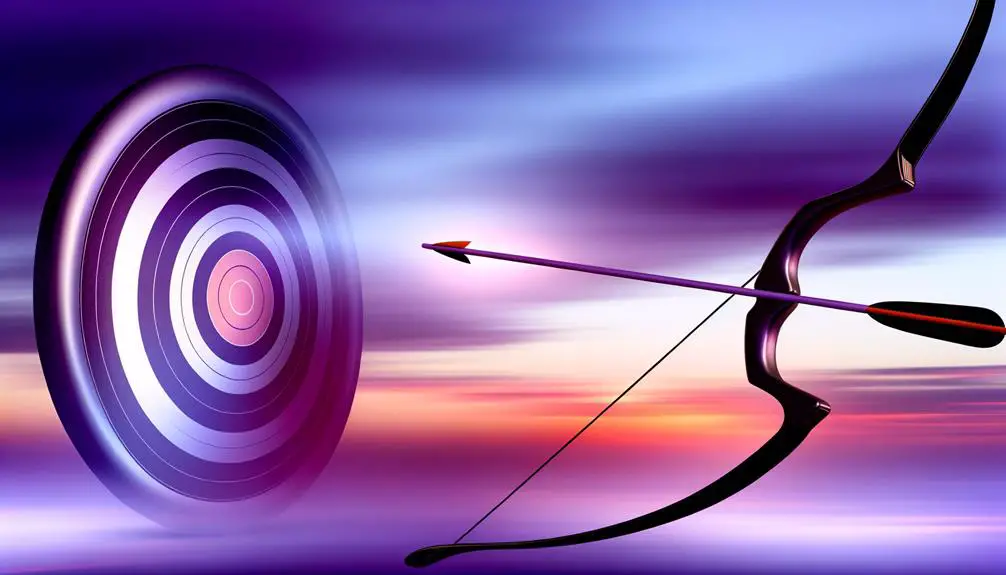
The bow and arrow are essential symbols of accuracy, embodying the meticulous skill and precision required to hit a target. This ancient weapon system represents the confluence of physical dexterity and mental acuity, underscoring the fundamental elements necessary for achieving exactness.
Accuracy in archery is not merely about hitting a mark but involves a thorough understanding of various dynamic factors:
- Trajectory Calculation: The archer must consider the arrow's flight path, influenced by gravity and wind.
- Steady Aim: Maintaining a stable posture and unwavering focus is crucial for precise release.
- Consistent Technique: Repetition and refining techniques are vital for achieving and maintaining accuracy.
In this context, the bow and arrow symbolize the harmony between skill and knowledge, epitomizing the essence of accuracy.
Metaphor for Focus
The bow and arrow serve as a profound metaphor for focus, encompassing the principles of precision and accuracy.
By embodying intentional targeting, it underscores the necessity of clear objectives and purposeful action.
Moreover, the act of drawing and releasing an arrow symbolizes mindful concentration, illustrating the alignment of mental clarity with physical execution.
Precision and Accuracy
Precision and accuracy in archery serve as powerful metaphors for the importance of focus in achieving one's goals. These concepts delineate the necessity of meticulous planning and execution in any endeavor. By examining the principles underpinning archery, we uncover valuable insights into goal attainment.
Key aspects include:
- Concentration: The archer must maintain unwavering focus on the target, mirroring the need for sustained attention in personal and professional pursuits.
- Consistency: Each shot requires repeated, consistent actions to achieve precision, reflecting the importance of reliable efforts in goal progression.
- Measurement: The archer must continually assess and adjust their technique, akin to the iterative process of evaluating and refining strategies to enhance accuracy in achieving objectives.
In essence, the bow and arrow epitomize the alignment of focus with disciplined practice.
Intentional Targeting
Drawing from the principles of precision and accuracy, intentional targeting underscores the necessity of deliberate focus in directing one's efforts towards specific objectives. This concept, akin to an archer zeroing in on a target, emphasizes the importance of discerning and prioritizing goals.
In both archery and life, success hinges not merely on the act of aiming but on the strategic selection of targets. The metaphorical bow and arrow illustrate that without clear intent, efforts can become dissipated, resulting in inefficacy. Intentional targeting requires a meticulous assessment of potential goals, ensuring that energy and resources are allocated efficiently.
Therefore, it serves as a critical framework for achieving the best outcomes in both personal and professional pursuits.
Mindful Concentration
Mindful concentration, much like an archer's unwavering focus on the bullseye, demands a disciplined and intentional allocation of mental resources. This metaphor underscores the significance of channeling one's cognitive energies toward a singular objective, thereby enhancing efficacy and precision.
In the domain of cognitive science, mindful concentration is linked to:
- Enhanced cognitive performance: Facilitating higher levels of problem-solving and creativity.
- Emotional regulation: Promoting a state of calmness and reducing stress by maintaining focus on the present task.
- Resilience to distractions: Strengthening the ability to filter out extraneous stimuli, thereby maintaining a clear path toward the goal.
Understanding this concept is paramount for those seeking to optimize their mental faculties and achieve peak performance in various life domains.
Tension and Release
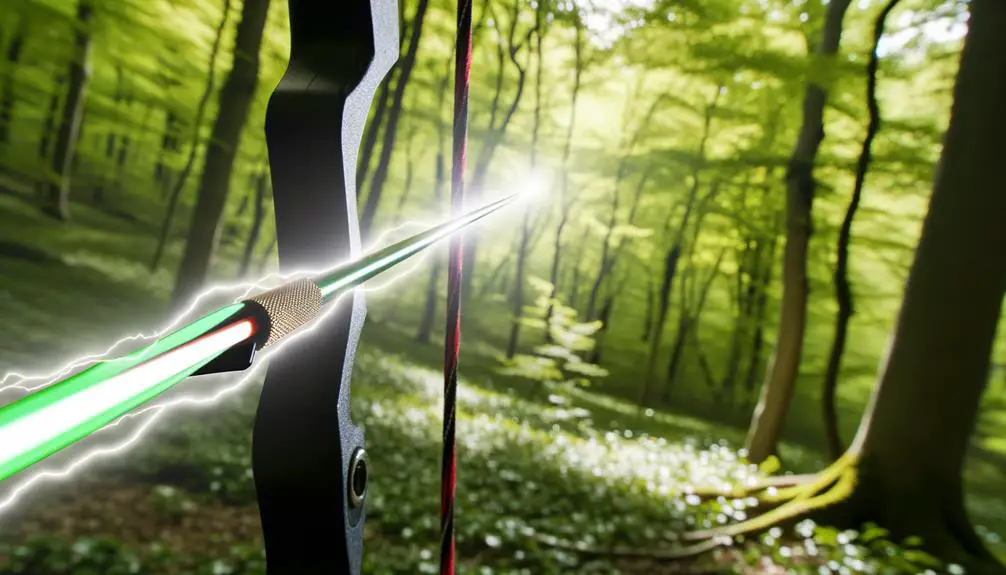
The interplay of tension and release in the use of a bow and arrow serves as a powerful metaphor for the cyclical nature of effort and reward.
When an archer draws the bow, tension accumulates, symbolizing the investment of energy, focus, and patience. This phase reflects the build-up of potential, akin to the preparatory stages of any significant endeavor.
Upon release, the arrow's flight represents the fruition of that effort, a moment of transformation where potential energy converts into kinetic energy. This dynamic underscores the necessity of balance; excessive tension may lead to breakage, while insufficient tension results in failure to achieve the target.
This way, tension and release encapsulate the delicate equilibrium required for effective action and successful outcomes.
Personal Empowerment
Just as the balance of tension and release is essential for effective action, the mastery of the bow and arrow also serves as a profound symbol of personal empowerment, illustrating how individuals can harness their inner strength and focus to achieve their goals.
The bow and arrow metaphor emphasizes the following key aspects of personal empowerment:
- Self-discipline: Mastery of the bow requires rigorous practice and control, reflecting the necessity of self-discipline in personal growth.
- Focus: The act of aiming symbolizes the importance of clear, directed intention in achieving one's objectives.
- Resilience: The archer's ability to adapt and refine technique underscores the value of resilience and perseverance in overcoming obstacles.
These elements collectively underscore the transformative journey towards self-empowerment.
Conclusion
The bow and arrow, a potent symbol, traverses the annals of history, mythology, culture, and art. It embodies precision, focus, and the delicate balance of tension and release. Its spiritual connotations and metaphorical significance in personal empowerment render it a timeless emblem.
This icon, etched in the collective consciousness, continues to resonate with both ancient and contemporary contexts. It illustrates the enduring human quest for mastery, intention, and transformation.


